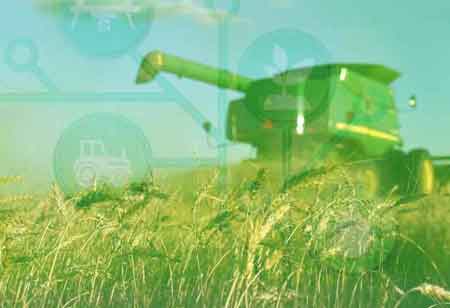Thank you for Subscribing to Agri Business Review Weekly Brief
Redefining Agriculture: Merging Tradition with Cutting-Edge Technology
The agriculture sector is witnessing a transformative shift as cutting-edge technologies increasingly blend with traditional practices.

By
Agri Business Review | Monday, February 17, 2025
Stay ahead of the industry with exclusive feature stories on the top companies, expert insights and the latest news delivered straight to your inbox. Subscribe today.
The agriculture sector is witnessing a transformative shift as cutting-edge technologies increasingly blend with traditional practices. AgTech solutions are essential in addressing the rising global food demand and tackling climate challenges. By enhancing efficiency, sustainability, and productivity, these technologies are not just optimizing farming practices but are also pivotal in reducing resource waste and maximizing profitability for farmers.
The most notable advancement is precision farming, which utilizes AI to refine agricultural practices. AgTech companies deploy advanced sensors, drones, and satellite imagery to collect real-time data on various factors such as soil health, moisture levels, and crop conditions. Machine learning algorithms analyze this data, providing actionable insights that empower farmers to apply fertilizers, pesticides, and water with unparalleled precision. This technological precision is crucial in minimizing resource wastage, boosting crop yields, and fostering sustainable and cost-effective farming.
The role of predictive analytics powered by AI has begun to revolutionize decision-making processes within the agricultural landscape. AI models can accurately forecast optimal planting and harvesting times by examining historical data, weather patterns, and market trends. These insights allow farmers to mitigate risks, adapt to climate changes, and optimize supply chain logistics. Additionally, AI-driven analytics are instrumental in the early detection of potential crop diseases and pest infestations, facilitating timely interventions to reduce losses.
Automation is another significant factor in reshaping agriculture, as AgTech providers introduce robotic solutions to alleviate labor-intensive tasks. Autonomous tractors, robotic harvesters, and drone-assisted planting systems enhance operational efficiency and lessen reliance on manual labor. As these technologies gain traction, farms position themselves to scale operations effectively while ensuring high-quality output amidst increasing demands.
Water management is a critical concern within the sector, spurring AgTech companies to develop AI-enabled irrigation systems that optimize water usage. These innovative systems harness sensors and real-time climate data to ascertain the precise water requirements for crops, contributing to waste reduction and resource conservation. In doing so, farmers enhance soil health and promote long-term sustainability, all while curtailing overwatering, runoff, and associated costs.
In livestock management, AI-driven solutions are making considerable strides, allowing for real-time health monitoring and behavioral analysis. These systems track animal movements, detect illnesses early, and optimize feeding schedules utilizing wearable sensors and computer vision technology. Such innovations elevate animal welfare, diminish veterinary expenses, and significantly enhance productivity across dairy, poultry, and cattle farming operations. Furthermore, AI systems support breeding selection processes, ensuring the propagation of stronger and healthier livestock lineages.
Supply chain management in agriculture is witnessing a revolution through the combined use of AI and blockchain technology. AgTech providers implement AI-driven platforms to track inventory, predict demand, and streamline distribution logistics. The integration of blockchain technology ensures traceability from farm to table, reinforcing consumer confidence in food safety and quality. This confluence of digital innovations reduces food waste, cuts transportation costs, and ultimately enhances market efficiency.
AgTech companies proactively employ AI to craft climate-smart farming solutions as the agricultural sector grapples with climate change-related challenges. By analyzing weather patterns, soil data, and crop genetics, AI models recommend practices that bolster climate resilience. Innovations such as vertical farming and hydroponics, enabled by AI-controlled environments, facilitate year-round food production independent of adverse weather conditions, thus strengthening food security and sustainability. Government and private sector entities are fostering AgTech innovation through various means of support, including funding, research initiatives, and infrastructure development. Grants and investment programs stimulate both startups and established firms to pursue the development of AI-driven solutions. Collaborative efforts between agricultural institutions and technology firms are crucial in accelerating the adoption of these digital technologies, ensuring that farmers benefit from the latest advancements.
Many successful AgTech implementations have led to significant improvements in farming outcomes. For instance, drone technology is used in vineyards to monitor crop health, enabling targeted interventions that enhance grape yield and quality. Additionally, companies have introduced soil sensing technology that optimizes irrigation and fertilization based on real-time data, while robotic harvesters reduce labor costs in fruit orchards. Smart irrigation systems help farmers efficiently manage water use, and blockchain solutions enhance supply chain transparency by allowing consumers to trace food products from farm to table. These innovations demonstrate how AgTech is transforming agricultural practices for better efficiency, sustainability, and productivity.
Despite the promising potential of AgTech, several obstacles hinder widespread adoption among farmers. High initial costs and limited digital literacy, particularly among older farmers, represent significant barriers to the seamless integration of these technologies. Concerns over data privacy further complicate the landscape, underscoring the need for initiatives that bridge the digital literacy gap. Continuous advancements in AgTech-targeted education campaigns and robust government support are fundamental to bridging these gaps.





